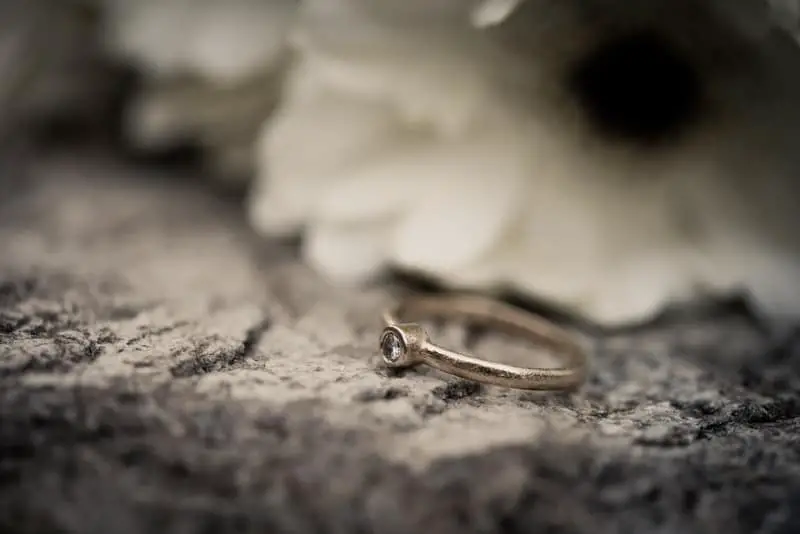We often cremate the deceased in America and our loved ones usually are wearing a nice set of clothes and all their jewelry. It’s a tradition that has lasted for thousands of years around the globe.
When you create a body it is carried out at a temperature ranging between 1400 to 1800 degrees Fahrenheit. So what happens to jewelry on a body when it is cremated?
The crematorium manager will ask you if you want to remove the jewelry before cremation. If you choose not to remove the jewelry, it is put into the incinerator with the body. The jewelry is then removed before the ashes go into the grinder. The leftover metals/stones are disposed of or recycled.
While the intense heat helps to reduce the body to the elements and dried bone fragments, it does not get hot enough to melt all metals and stones in jewelry.
Often people will take the jewelry before the body even goes into the fire. However, there are a lot of misconceptions about cremations and what happens with jewelry and the dead, read on to learn the truth.

What happens at a cremation service?
To understand what happens to jewelry and when it happens you have to know the process of the cremation at a crematorium.
Cremations and what happens in the background of these places seem like a mystery to people and there are a lot of rumors and unsolidified claims.
There are some instances of unsavory behavior where managers or workers at these places did not follow procedures and local laws (as with any business). Though for the most part crematoriums are inspected regularly and held to a very high standard. Here are the key points of what, why and how it happens.
- When the family members of the deceased choose the process of a cremation a few questions will be asked. The major one is do they want the casket and all the belongings inside to go into the retort ( known as the cremation chamber)? They will be informed to remove jewelry items like necklaces, watches, rings, military medals and other similar objects Since these objects will most likely break down if not fully melt during the process of cremation.
- The process will take place in a cremation chamber and that chamber is preheated to a set temperature. The body will then be placed on a conveyor belt and is quickly transferred into the actual fire through a door to avoid losing heat.
- During incineration, the body is exposed and will be in multiple flames fueled usually by natural gas or propane.
- The casket and container will burn first if there is one.
- Next, the heat will dry up the body and eventually vaporize it and the bones will calcify and crumble. The gases will be released through an exhaust system usually with some sort of filters depending on the local laws.
- The bodies are burned one at a time and there is usually no smell the process vaporizes the gases that would cause the smell.
- The result of the corpse is that it is reduced to skeletal remains and bone fragments. These bits are collected in a tray and it stays in the chamber to cool down.
- Within these remains, there also non-consumed metals from the casket such as screws, nails, hinges, etc.
- There are also any jewelry, medals, dental work, surgical screws, implants, etc. These objects can be removed with the help of magnets and manual inspection. These metals are disposed of as per the local law.
- The metal pieces are removed before the next process because they may damage the equipment that is used to grind down the last of the remains.
- These last bone pieces and fragments are usually ground down to a sand-like material consistency and put into a container of the families choosing. Then given to the family to take home or placed somewhere.
What happens to the metals when the body is burned?
If it is jewelry or the metals in the body from medical producers they can all go into the cremation chamber (except for a pacemaker as it has a battery and can explode).
During the cremation, the temperature of the furnace is extremely hot it may not be hot enough to melt certain types of metals. The furnace gets around 1600 degrees Fahrenheit, below are the melting points of certain metals commonly in jewelry and used for medical procedures.
- Amalgam- Silver/Copper/Iron, etc. varies on composition
- Aluminum- 1,221 degrees Fahrenheit
- Copper- 1,984 degrees Fahrenheit
- Gold- 1,948 degrees Fahrenheit
- Silver- 1,763 degrees Fahrenheit
- Titanium- 3,034 degrees Fahrenheit
- Steel- 2,500 degrees Fahrenheit
As you can see above, if the jewelry is of a pure element, most will not melt at the temperature the furnace gets to. Most jewelry is not pure so it will melt down and bond with the bones and ashes. After it has done this it is very hard to separate the materials and you need to have it professionally done.
The issue is that some states and jurisdictions will not also this as a sanitary measure, they say that it is a toxic material. There are not a lot of places in the US that do this but it is becoming more prevalent to either recover the materials for yourself or to have them recycled.
So if you want the materials or want them recycled be sure to check with the funeral home and state laws so this can be done legally and in a professional manner.
In regards to the ashes themselves, ironically you can get THEM turned into jewelry for a perfect keepsake of your departed love ones. This is a great option where you get the ashes made into a permanent piece of jewelry, you should check out the beautiful handcrafted pieces Mark Hamilton makes with cremains by visiting his site here.
Can I donate the leftover metal?
This option has been around for a while and was often done without even informing the family members of the deceased. What’s more commonly done now is that they are asked about what they would like to do with the leftover metals from the remains.
Often with or without your consent, depending on state laws, the crematorium will send the metals to a recycling company. They have specific ones that deal with separating the materials from humans remain in a professional and respectful fashion.
After the materials are separated the metal is then bought by that company or sold to a third party. The proceeds could be collected by you, returned to the crematorium, or donated to a local charity.
Donating the proceeds to a local charity is a great way to give back in the person who has passed the name and honor their legacy.
Are all recycling and metal recovery the same?
No, they are not. There are now a growing number of businesses that offer to recycle the metals that can be recovered from your cremations.
The post-cremation metals recycling business if rapidly expanding and growing in America. In the past, this heavy metals such as gold, silver, platinum, etc had to be buried, which was not only harmful to the environment but a waste of a finite resource.
Not all of these companies care about environmental compliance and may just be in it for the monetary gains. With all the companies out there be sure to check out their values and ask come questions. You also want to find one that will give you a fair return on the metals and be as eco-friendly as possible. A few questions to ask them are:
- Are they EPA compliant?
- Can they show you their Federal EPA manifest and permit?
- Can you see the facilities?
- Do you have customer feedback and may you talk to some of them?
Is there any other type of cremation that does not involve fire?
Yes, there is and it is much more eco friendly than traditional cremations. Many believe that the future of cremation is in Alkaline hydrolysis (also known as aquamation, biocremation, or water cremation).
This process uses lye and heat to break down the body by dissolving it. It is available in about 18 states and growing every year. You may not have heard about it, as it goes by even more names than above such as resomation, green cremation, or flameless cremation.
Can I keep the metals from the teeth?
This is the most commonly asked question about keeping metals from remains. Gold and other metals are often used in tooth fillings or to cap a tooth for a “grill or front” as jewelry.
Dental gold is not pure and will not survive the high temperatures. It can be removed from the body before the cremation process begins. It will have to be done by a dentist as a mortician is not trained in this area.
It is a very expensive process and may not even cover the metals you are taking out of the mouth. If the metals are put into the furnace after they are disposed of by being recycled or disposed of.
Can the family witness the cremation?
Yes, in most crematoriums, the family is allowed to witness the cremation. A separate viewing room so you can see into the chamber is normal.
How long does it take to cremate a body?
It takes about two to four hours from start to finish the process but it is just until the body is reduced to bones and fragments. It will also depend on the size of the body.
Can you rent a casket?
Yes, you can rent a casket and the body is just put into a cardboard box before it enters the chamber. This is an ideal way to save money, you can read more about this process in my full article on renting caskets.
I recently looked into getting a loan and I’ve actually had a good experience with Supermoney.com. For me, it was a car loan but I spoke to them about a dedicated funeral expenses loan, which is one of the services they offer and was quite impressed. To see if you could qualify, check out my link here.




